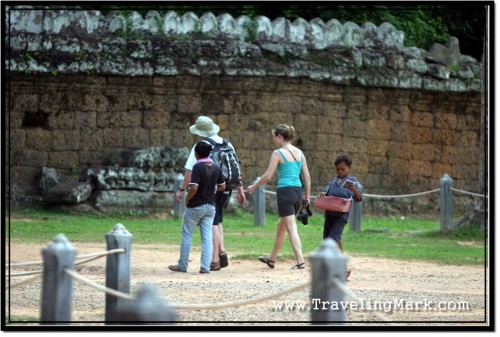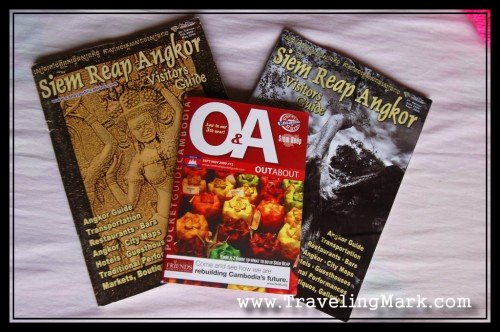Angkor area touts have been bastardizing the experience for visitors to Angkor Archaeological Park ever since the beginnings of the mass tourism in Cambodia, but the more visitors the temples attract, the more aggressive they get. Needless to say, regardless of how majestic the temples of Angkor may be, a visit to the park is accompanied with a great deal of frustration and dismay. You can only say “No, thank you” the first two million times before it gets disheartening and demoralizing. Visitors are justifiably resentful and often turn bitter with each additional importunity that befalls upon their every step. You can see the frustration on their faces when after a long struggle to shake off an aggressive tout they get jumped by a fresh load of new half a dozen.

Locals realized that noone can put up with so much pressure and still be willing to listen to them when they want to sell you some more useless junk, so they instructed the kids they use to pester the visitors with to respond to each turn-down with the “Where are you from?” question. Obviously, every foreigner who has been in Cambodia for more than five minutes will have already been subjected to so much pressure from the Tuk Tuk drivers and omnipresent scammers they can no longer take it so by the time they make it all the way to Angkor, they are already in full “ignore” mode and will not consider any offer from a tout, no matter what it is they have. To counter this defiance foreigners are forced into, pestering kids are instructed to engage the foreigner by asking them where they were from.
Touts plain and simple already know that every foreigner will respond with either a polite “No, thank you” or by not responding at all when initially approached by a pest. No matter how hard boiled you are, no matter how much you can take, Cambodians are so aggressive and rude, the threshold will be crossed within hours, if not minutes of your visit. So it is natural you will not be willing to consider any additional offers from any more of those touts and they know it darn well. Their way to get by it is by asking the “Where are you from?” question, because it’s a question everyone who’s traveling likes to be asked and – what’s important for the touts – to answer. By asking where you were from, they will engage you in a conversation despite your initial defiance you were forced into by excessive hostility from touts you have previously been exposed to and that’s what they want.
The “Where are you from?” question is nothing less and nothing more than a sneaky way to trick you into spending more money on useless junk after you have already been tricked into spending more than too much money on useless junk. When a Cambodian asks you where you were from, it’s not because they want to know where you were from. They don’t care one bit about your country of origin or anything else related to you. All they care about, all they want is your money. Remember, to a Cambodian you are not a person, but a wandering ATM machine.
So in order to succeed with their sole goal of getting the money out of you, the kids who are set on foreigners are instructed to counter their defiance with the “Where are you from?” question. They are further taught basic facts about the top ten (or so) countries that send the most visitors to Cambodia to follow it up by impressing you with what would appear as “knowledge of your home country”. In my case, it would go something like this:
Tout: Hello, buy postcard? Only one dollar!
Me: No, thank you. I’ve already bought postcards and have more than I need.
Tout: Where are you from?
Me: Canada.
Tout: Capital city Ottawa. Population 32 Million. You speak two languages.
Me: That’s right. Very impressive…
And now they have me engaged and in a frame of mind which to a civilized westerner dictates that you should feel obliged to reward them for the time and dedication they had demonstrated. And this is exactly what they are counting on. They play with the psyche, knowing very well that the westerners are brought up being polite so they abuse it for their personal enrichment.
Being me, however, there was no way I could buy any more of their postcards. When you travel around the world, you only have so much room in your backpack and the more you buy, the more you have to carry and that’s really not an option. On top of that, I’m a traveler on a budget so no matter how hard a tout would try, I’m not buying anything that’s not a necessity.
They got me the first time and I played their game when asked where I was from, but then I changed the rules of the game and made myself the leader, not the follower. That gave me instant advantages plus it gave me amusement and saved me from a lot of headache. I had them figured out all throughout so when next time a tout got on me to pester me with useless junk, I already knew how I was going to respond. This is how my next encounter went:
Tout: Hello, buy postcard? Only one dollar!
Me: No, thank you. I’ve already bought postcards and have more than I need.
Tout: Where are you from?
Me: Guyana.
Tout: …
Not a word of response. The tout simply turned around and never bothered me again. I really liked this game and kept playing. Next tout jumped me and it went like this:
Tout: Hello, buy postcard? Only one dollar!
Me: No, thank you. I’ve already bought postcards and have more than I need.
Tout: Where are you from?
Me: Why are you asking?
Tout: What?
Me: Why are you asking?
Tout: I don’t know what capital of wiasing is 🙁
I got them by the balls and kept playing my game to ease my way through Angkor. Kids kept pestering me on every step but by playing my own game with them I caught them off guard with responses they did not expect which resulted in fast and easy shake off. Obviously, when they spot a Caucasian guy, they anticipate to be told that he was from one of the countries that make for 95% of all Caucasian people who visit Angkor. Those likely include the USA, Canada, England, Germany, Russia, France, Sweden, Belgium, etc. They memorize the capital cities and a few impressive facts about each of those top countries and recite them as responses matching the answer you provide. Quite a clever way to pester the visitors but it didn’t get them too far with me.
